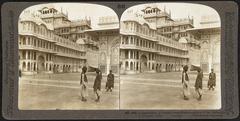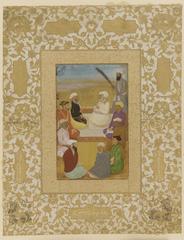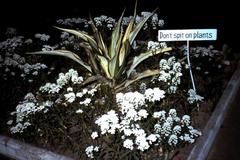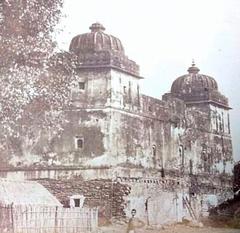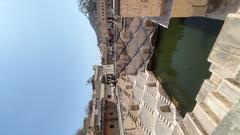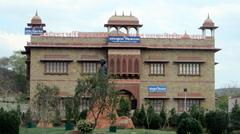Ganesh Pol Jaipur: Visiting Hours, Tickets, and Historical Significance
Date: 14/06/2025
Introduction
Ganesh Pol, the grand gateway of Jaipur’s Amer (Amber) Fort, stands as a testament to Rajasthan’s royal legacy and architectural brilliance. Renowned for its harmonious blend of Rajput and Mughal styles, intricate frescoes, and rich cultural symbolism, Ganesh Pol is not only an iconic structure but also a living chronicle of the Kachwaha dynasty’s grandeur. This comprehensive guide will detail Ganesh Pol’s history, architectural features, visiting information, nearby attractions, and essential visitor tips, ensuring an enriching experience for anyone exploring Jaipur’s historical sites.
Historical Overview
Origins and Architectural Evolution
Constructed between 1611 and 1667 CE during the reign of Raja Jai Singh I, Ganesh Pol was designed as the principal gateway leading to the Maharaja’s private palaces within Amer Fort. Its creation reflected the growing influence of the Kachwaha Rajput dynasty and their strategic alliance with the Mughal Empire (Navrang India; Tourism Bharat). The gateway’s architecture is a masterful synthesis of Rajput vibrancy and Mughal elegance, featuring red sandstone, white marble, intricately carved arches, chhatris (domed pavilions), and jali (latticework) screens.
Symbolism and Religious Significance
Ganesh Pol derives its name from the prominent image of Lord Ganesha, the Hindu deity revered as the remover of obstacles and the god of new beginnings. This unique profile depiction of Ganesha, centrally placed above the main arch, sanctifies the gateway and marks the threshold between public and private royal spaces (Jaipur.org). It is both a spiritual and architectural landmark, reinforcing the sacredness and exclusivity of the Maharaja’s residence.
Architectural Features and Decorative Artistry
Ganesh Pol is celebrated for its elaborate decorative elements. The façade boasts vibrant frescoes, floral motifs, geometric patterns, and mythological scenes, painted with natural pigments that have remarkably retained their color over centuries (The Design Gesture). The ceiling features panels with celestial beings and ornamental designs, creating a play of light and shadow throughout the day.
Key features include:
- Chhatris and Domes: Crowning elements typical of Rajput architecture, symbolizing royal authority.
- Lattice Screens (Jali): Allowing privacy and ventilation, they enabled royal women to observe courtyard events without being seen.
- Massive Wooden Doors: Reinforced with iron spikes, reflecting the fort’s defensive priorities.
- Mosaic and Inlay Work: Glass, semi-precious stones, and mirror inlays enhance the arches and domes.
Role in Royal Life and Ceremonies
Historically, Ganesh Pol served as the ceremonial entrance for the royal family, marking the transition from public spaces like Jaleb Chowk to the private quarters. During festivals and state occasions, the gateway would be adorned with flowers and fabrics, forming the backdrop for royal processions featuring elephants, horses, and musicians (Tourism Bharat). Its elevated balconies offered discreet vantage points for the royal household.
Cultural Synthesis and Historical Context
The period when Ganesh Pol was built was marked by peace and prosperity in Rajasthan, fostered by Rajput-Mughal alliances. The gateway’s architectural vocabulary—cusped arches, ornamental brackets, and symmetrical layouts—mirrors this syncretic culture, blending Hindu iconography with Mughal design elements (Jaipur.org). Ganesh Pol set the standard for royal gateways across Rajasthan and remains a symbol of artistic and spiritual unity (Navrang India).
Preservation and Contemporary Relevance
Today, Ganesh Pol is a protected monument as part of Amer Fort, which was inscribed as a UNESCO World Heritage Site in 2013 (Navrang India). Conservation efforts focus on preserving its frescoes and structural integrity using traditional materials and techniques. The gateway continues to captivate visitors, serving as a focal point for tours, photography, and cultural events (Tourism Bharat).
Visiting Ganesh Pol: Practical Information
Location and Access
Ganesh Pol is situated within Amer Fort, about 11 km northeast of Jaipur city. The fort is accessible via taxi, auto-rickshaw, bus (routes #1, #5, #3B), and private tours, with parking available near the entrance. The gateway itself is at the far end of Jaleb Chowk, the main courtyard (Explore Amer Fort and Ganesh Pol details; Jaipurthrumylens).
Visiting Hours
- Open Daily: 8:00 AM to 5:30 PM (Official Amer Fort timings)
- Best Time: Early morning or late afternoon for optimal light and fewer crowds.
Ticket Prices
- Indian Nationals: INR 100–150
- Foreign Tourists: INR 500–600
- Children and Students: Discounts available with valid ID
- Light & Sound Show: Separate ticket required for evening shows (Light & Sound Show details)
- Tickets: Purchase at the entrance or online (Official Amer Fort Tickets)
Accessibility
The fort complex has uneven pathways and stairs. Ganesh Pol is accessible via a broad staircase, but wheelchair access is limited. Ramps and assistance are available at the main entrance; plan ahead for special needs.
Visitor Facilities and Tips
- Restrooms: Available near the palace exit.
- Food & Drink: On-site restaurants and snack stalls; heritage dining options in Amer town.
- Shops: Souvenir shops within the fort—exercise discretion regarding prices.
- Dress Code: Modest attire and comfortable shoes recommended.
- Hydration: Carry water, especially in warmer months.
- Guided Tours: Available on-site and online; official guides are recommended for accurate information.
Safety and Etiquette
- Crowds: Ganesh Pol can be busy during peak times—keep valuables secure.
- Photography: Allowed, but avoid flash inside frescoed chambers. Early morning offers the best light (Photography tips at Ganesh Pol).
- Authorized Guides: Use only those with official badges.
Nearby Attractions
- Jaigarh Fort: Linked via passageways, home to the world’s largest wheeled cannon.
- Nahargarh Fort: Offers panoramic city views, especially at sunset.
- Panna Meena ka Kund: 16th-century stepwell with striking geometry.
- Jal Mahal: Lake palace visible from Amer road.
- Sheesh Mahal: Famed Mirror Palace within Amer Fort.
- City Palace, Jantar Mantar, Albert Hall Museum: Located in central Jaipur.
- Religious Sites: Moti Dungri Ganesh Temple, Birla Mandir, Galtaji Temple, Govind Dev Ji Temple.
Cultural Experiences
- Light and Sound Show: Evening shows narrate Jaipur’s royal history.
- Elephant/Jeep Rides: Popular for ascending to the fort; jeeps are recommended for animal-conscious visitors.
- Local Markets: Explore for Rajasthani handicrafts and textiles.
Sample Itinerary
- Arrive early and begin at Ganesh Pol.
- Tour Amer Fort, including Sheesh Mahal and Mughal Garden.
- Visit Jaigarh Fort and Panna Meena ka Kund.
- Pause for views at Jal Mahal.
- Explore Nahargarh Fort for sunset.
- Conclude with central Jaipur’s City Palace and Jantar Mantar.
Frequently Asked Questions (FAQ)
Q: What are the Ganesh Pol visiting hours?
A: 8:00 AM to 5:30 PM daily.
Q: How much are tickets for Amer Fort and Ganesh Pol?
A: INR 100–150 for Indians, INR 500–600 for foreigners; Ganesh Pol access is included.
Q: Is Ganesh Pol wheelchair accessible?
A: Accessibility is limited; partial access is possible with assistance.
Q: Are guided tours available?
A: Yes, both group and private tours are available on-site and online.
Q: When is the best time to visit Ganesh Pol?
A: October to March for pleasant weather; early mornings or late afternoons for the best experience.
Notable Facts and Figures
- Construction: 1611–1667 CE
- Architectural Style: Rajput-Mughal fusion
- Materials: Red sandstone, white marble, natural pigments
- Function: Gateway to Maharaja’s private quarters
- Iconography: Profiled Lord Ganesha above the arch
- UNESCO Status: Part of the Hill Forts of Rajasthan since 2013
- Location: South side of Amer Fort’s main courtyard (Jaipur.org)
Planning and Additional Resources
- Official Contact: +91 141 253 0293 (Official Amer Fort Website)
- Travel Apps: Download the Audiala app for guided tours, maps, and live updates.
- Internal Links: Explore related articles such as “Top Historical Sites in Jaipur,” “Guide to Amer Fort,” and “Jaipur Travel Tips.”
- External Links: Refer to official tourism and reference sites for real-time updates and bookings.
Conclusion
Ganesh Pol is not just an architectural marvel but a vibrant gateway into Rajasthan’s royal past. Its intricate artistry, cultural symbolism, and historical importance make it an essential stop for any visitor to Jaipur. By planning your visit with the tips and resources provided here, you can fully appreciate the legacy and living heritage embodied by Ganesh Pol and the Amer Fort complex.
Sources
- Ganesh Pol at Amer Fort: Visiting Hours, Tickets, History, and Cultural Significance in Jaipur, 2024, Navrang India (http://www.navrangindia.in/2024/12/amer-or-amber-fort-jaipur-fine-symbol.html)
- Ganesh Pol at Amer Fort: Visiting Hours, Tickets, History, and Cultural Significance in Jaipur, 2024, Tourism Bharat (https://tourismbharat.com/rajasthan-tourism/amer-fort-everything-you-need-to-know/)
- Ganesh Pol in Amber Fort, Jai Mandir in Amber Fort, Jas Mindir in Amber Fort, 2016, Jaipur.org (https://jaipur.org/2016/08/05/ganesh-pol-in-amber-fort-jai-mandir-in-amber-fort-jas-mindir-in-amber-fort/)
- Amer Fort: Magnificent Gem of Rajasthan Tourism, 2024, The Design Gesture (https://thedesigngesture.com/amer-fort-magnificent-gem-rajasthan-tourism/)
- Ganesh Pol Visiting Hours, Tickets, and Nearby Historical Sites in Jaipur, 2025, Jaipurthrumylens (https://jaipurthrumylens.com/2018/06/26/amer-fort-jaipur-guide/)
- Official Amer Fort Tickets, 2025, Rajasthan Tourism (https://rajasthantourism.gov.in/amer-fort)

